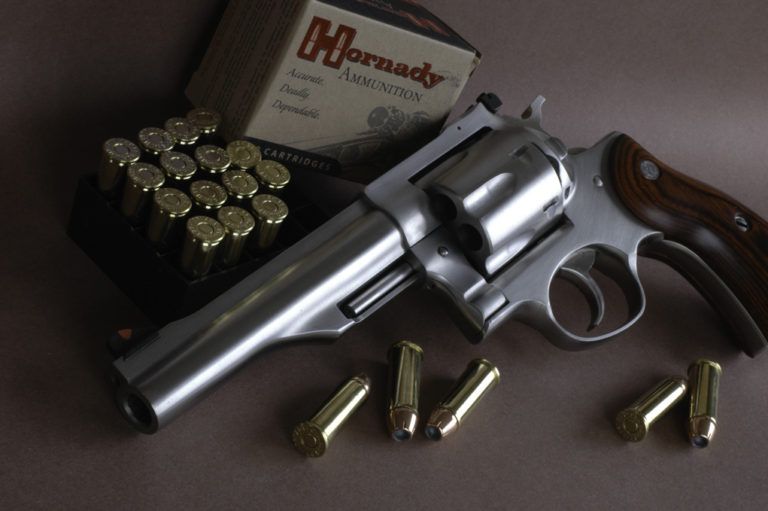
Ruger's Redhawk and Super Redhawk are both classics, but chambered in powerful .44 Magnum does double-action revolver outshine the other?
Ruger Redhawk .44 Magnum Specs:
- Capacity: 6 rounds
- Barrel Length: 4.2 to 7.5 inches
- Overall Length: 9.5 to 13 inches
- Weight: 47 to 59 ounces
- Frame: Stanless Steel
- Finish: Satin
- Front Sight: Ramp
- Rear Sight: Adjustable
- MSRP: $1,079 to $1,159
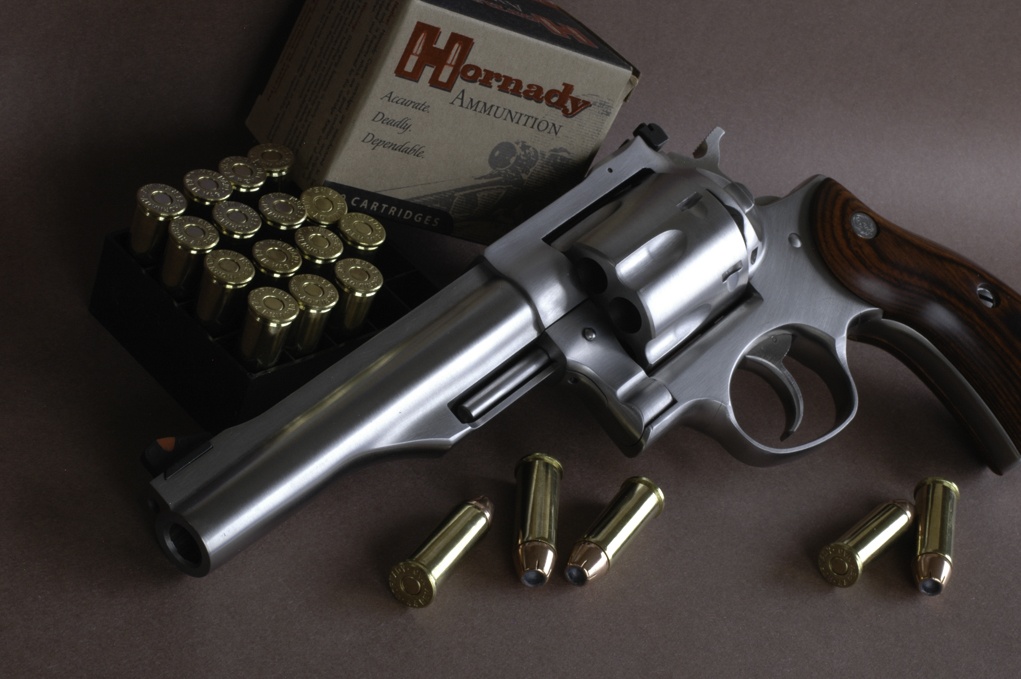
Some people choose powerful firearms for the reason adolescent boys crave muscle-cars: image. My drift to 1911 pistols and large-frame revolvers was instead pragmatic. My pork-chop paws engulfed smaller handguns. Finger curled about the trigger like a shrimp, my leading knuckle crowded the muzzle. But to give pocket guns a fair shake, I ran the numbers. Ruger’s LCP and LCR measure about 5.2 and 6.5 inches in length. My hand tapes 8.7.
Revolvers that fit me date to the 1840s, though I don’t. Economic depression followed the panic of 1837. In 1841, Samuel Colt’s Paterson plant closed. Colt found work with Samuel Morse, until in 1846, a visit from Samuel Walker of the Texas Rangers turned his attention again to guns. The resulting Walker Colt was a 4 1/2-pound .44, to be manufactured at Ely Whitney’s plant. Few were shipped. Short months later, Captain Walker fell to a Mexican lance at the Battle of Juamantla.
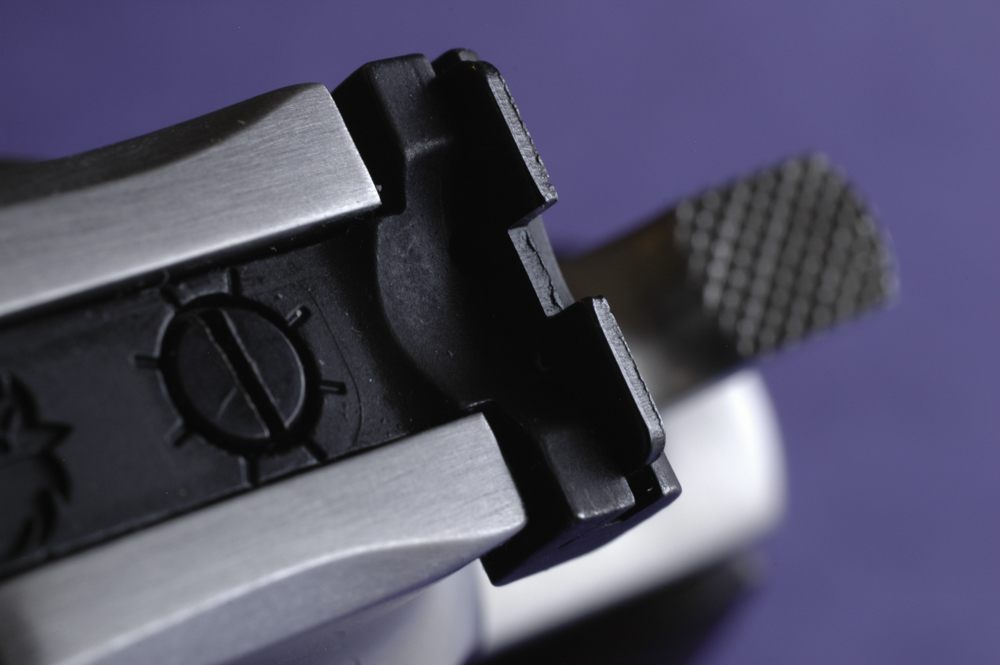
War clouds fueled development of Colt’s 1860 Army. The 1873 Peacemaker followed, an instant success. The .45 Long Colt, initially loaded with 28 grains black powder behind a 230-grain bullet, earned its deadly reputation with a 40-grain charge, a 255-grain bullet. The U.S. Army adopted this single-action sidearm in 1875. Three years later, Colt bored its 1873 Model P Peacemaker Single Action Army for the .44-40, already available in Winchester’s 1873 rifle. That dual chambering profited both firms, ensuring a ready supply of .44-40 ammunition across the West and absolving customers of packing two loads.
Find Out More About Ruger Firearms
Meanwhile, Smith & Wesson saw promise in double-action revolvers. In 1905, a full decade after smokeless powder arrived, it built a .44 Special revolver for a black-powder load, 26 grains driving a 246-grain bullet through nine 7/8-inch pine boards! The .44 Hand Ejector appeared in 1907. The .44 Military Model of 1908 became the “Triple Lock,” as it latched at the breech, forward of the extractor and between yoke and extractor shroud. Refinements followed. The Fourth Model, or 1950 Target, got the attention of an Idaho cowboy, who began crusading for a revolver cartridge to upstage the .357, announced in 1935 on S&W’s .38/44 frame. Elmer Keith’s .44 Special handloads presaged an even more potent round.
As the .357 got its zip from a case slightly longer than a .38 Special’s, so the .44 Magnum gained its edge on the .44 Special. In 1954, Remington’s first factory loads hurled 240-grain bullets at 1,350 fps, effectively doubling the blow of the .45 Colt. Smith added steel to its 1950 frame, hiking pistol heft from 40 to 47 ounces. The Model 29 .44 Magnum revolver went public in 1956.
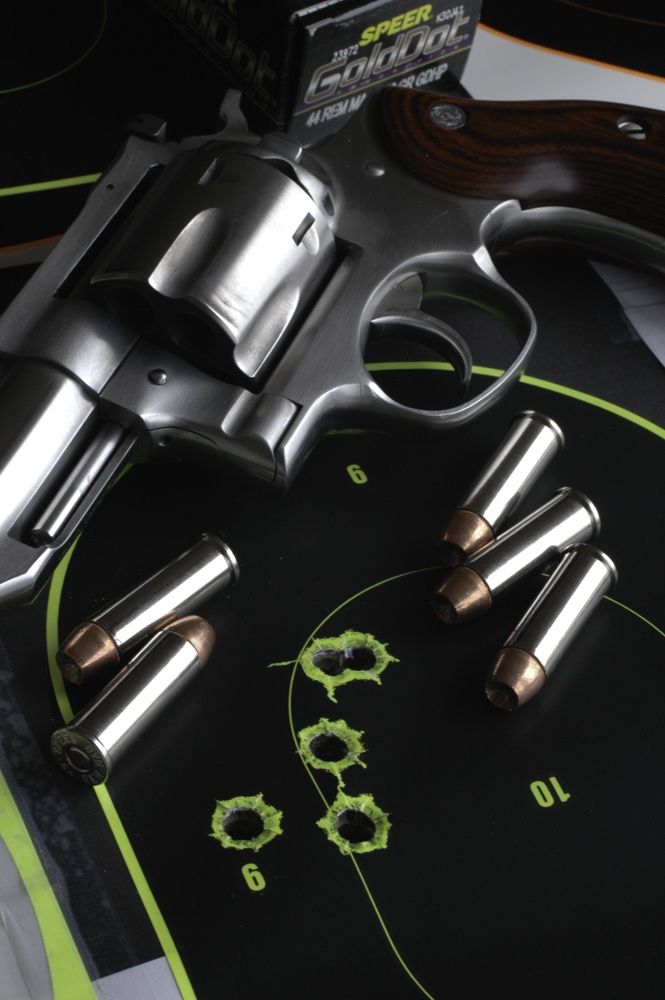
Sturm, Ruger came late to the revolver game but quickly showed Bill Ruger’s genius. The .357 Blackhawk appeared in 1955, the .44 a year later. These “Flattops” anchored a single-action series that’s still strong at market. A medium-frame .357 double-action arrived in 1970, but the big news from Ruger that decade came at its end. During the NRA show in San Antonio in May 1979, the company unveiled its Redhawk, a six-shot DA .44 Magnum. That year was Sturm, Ruger’s 30th — and most profitable. Sales reached $68.9 million, the net topping $7.9 million. Those figures surpassed 1978 returns by 15 and 13 percent. Clearly, Ruger was producing what shooters wanted.
Struggling into solvency after college, I wasn’t then able to snare a .44 Redhawk. But it was soon in my sights, an alluring combination of strength and elegance, tradition and innovation.
Engineers Harry Sefried and Roy Melcher made the Redhawk what it is, but Harry credited Bill Ruger with the offset ejector rod. Breaking with tradition, it’s not in the frame’s center and doesn’t rotate coaxially with the cylinder. So located, it permits a beefier frame next to the rod. The steel there is nearly twice as thick as it would have been with a frame-centered ejector. Another departure from the norm is the cylinder latch. Instead of a sliding tab, it’s a button that releases when depressed. I prefer it, as firing with gloves on big hands can accidentally move a fore-and-aft latch.
The Redhawk’s crane locks into the frame, where it’s held much more securely than if relegated to a forward under-barrel lug. Ruger described this as a “triple-locking” (not Triple Lock!) revolver, the cylinder secured “front, rear and bottom.” In this respect, the Redhawk was more rugged than any other DA then on the market. Sefried observed the lockup “would last about indefinitely.” The barrel has plenty of brawn, too, with 3/4×20-pitch threads.
A flat-nosed hammer falls on a transfer bar. A single coil spring powers two linkages: one to push the hammer, the other to return the trigger. Smith & Wesson DAs have two springs, a system Sefried said increases trigger pull without adding hammer thrust. Colt’s two-legged flat spring yields a lighter pull but does not assist the hammer. Bill Ruger insisted on a trigger-weight setting “in the range of conventional double-action revolvers,” so I shouldn’t have been surprised when Redhawk pulls I weighed came in at 6 1/2 pounds SA and 11 DA. Both were smooth and felt lighter. According to Ruger engineers, the Redhawk reliably ignites primers with a DA pull as light as 7 pounds.
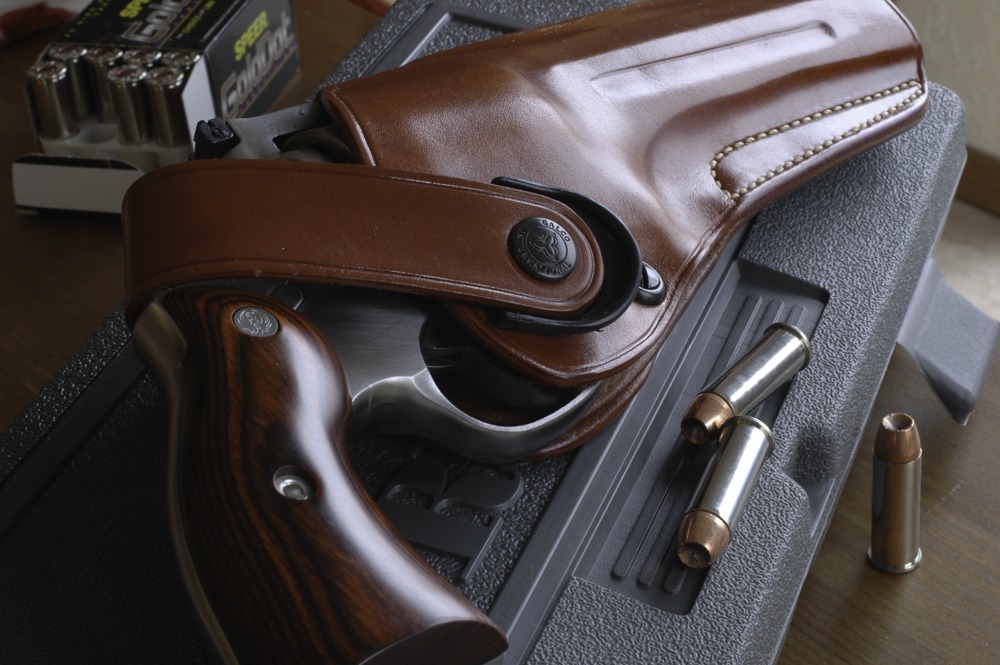
Introduced with barrel lengths of 5 1/2 and 7 1/2 inches, the .44 Magnum Redhawk arrived as the “logical evolution of the now-famous line of Ruger double-action revolvers.” But it was also an “entirely new firearm, representing the most significant advance in the development of heavy frame double-action revolvers in many decades.” The company also noted, “With the accuracy and power of the .44 Magnum cartridge [the Redhawk will] be widely used as a hunting revolver.” It’s since been chambered in .357 and .41 Magnum, and in .45 Colt. Ruger’s latest catalog lists the .44 Magnum with hardwood grips and 5 1/2- and 7 1/2-inch barrels, including a Hunter model with scope ring dimples on the 7 1/2-inch rib. There’s a .45 Colt/.45 ACP version with hardwood, a .45 Colt or .44 Magnum with Hogue Monogrips. Both have 4 1/4-inch barrels. A new round-butt, hardwood .357 holds eight shots behind a 2 3/4-inch barrel.
In past years, this pistol has been listed with blued chrome-moly steel, but now all versions are of brushed stainless. Sights are blued C-M. The replaceable front blade has a red plastic insert, the adjustable rear a white-outline square notch.
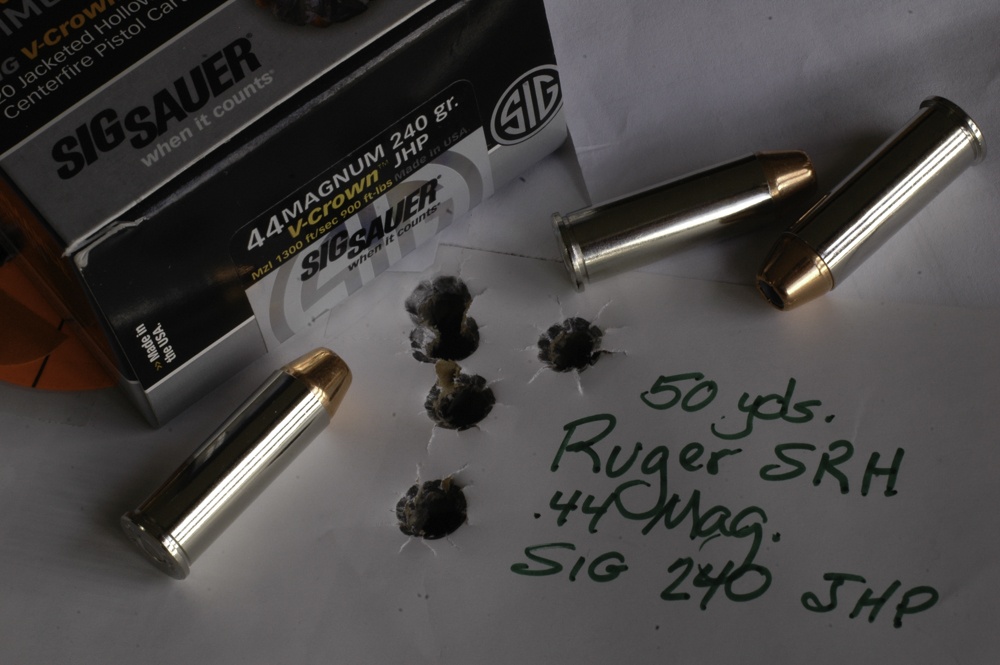
When life became unbearably hollow without a Redhawk, I yielded. The price had climbed well above the 1980 MSRP of $325. My consolation: it has kept rising. Good things seem never to go on sale, and I suspect the current figure ($1,079) will soon be eclipsed. I picked the 5 1/2-inch .44 because I like wood grips and think a 5 1/2-inch barrel gives a big revolver visual and physical balance. Recoil is more violent in shorter, lighter .44s, which also sacrifice sight radius. A 7 1/2-inch barrel brings heft from 49 to 54 ounces, quickly making the Redhawk a two-hand gun. Even if I almost always use two, it seems to me a handgun shouldn’t require both.
Unlike later Ruger DAs built with separate grip frames, the Redhawk’s grip is integral with the frame proper. There are no sideplates. You can disassemble the Redhawk without tools, but I used a screwdriver to release the grips. A pin fell — from where I could not tell. Read the instructions, Dummy! The manual confirmed what I’d suspected. The pin has no function in the assembled pistol; it secures the mainspring and strut during disassembly.
Firing the Redhawk won’t put you to sleep, but the hardwood grips are thoughtfully shaped and mercifully smooth. They slip slightly in your hand as the gun rotates up in recoil, absorbing bite. While pliable rubber absorbs shock, it also ensures that all the kick reaches you before it leaks energy moving the pistol. Redhawk sights give me the square, sharp image I like in irons.
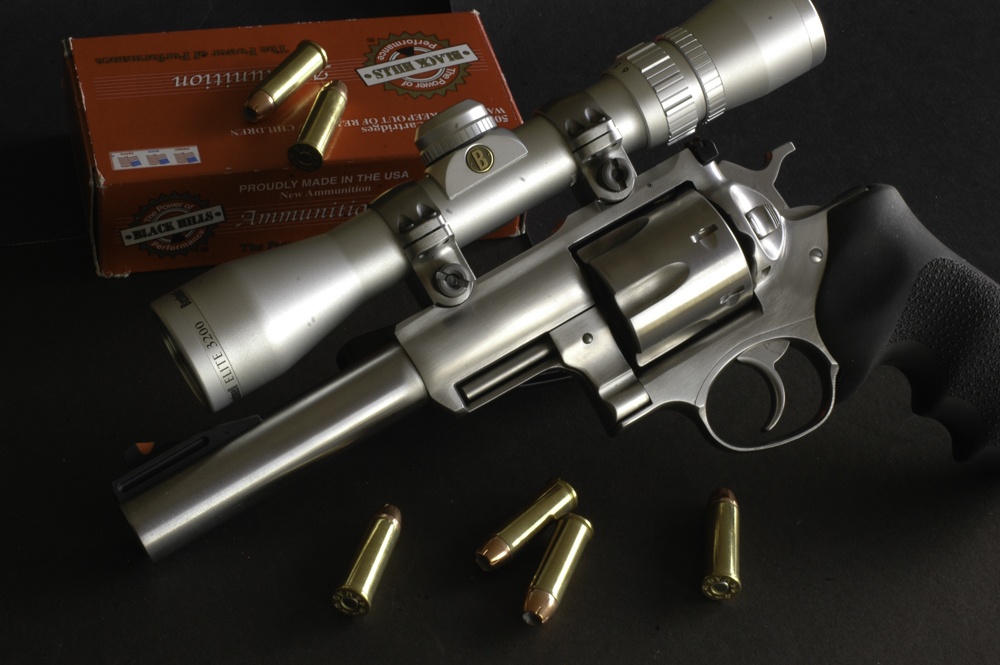
In range trials, my Redhawk has printed pleasing groups with bullets of 180 to 300 grains. Nixing shots I pulled or wobbled out, I managed to threaten the 2-inch mark at 25 yards with the loads at hand.
| Load | Group (in.) |
| Remington 180-gr. SJHP | 2.1 |
| Hornady 200-gr. XTP | 2.2 |
| Speer 210-gr. Gold Dot | 1.9 |
| Federal 240-gr. JHP | 2.2 |
| Winchester 250-gr. PTHP | 2.4 |
| Black Hills 300-gr. JHP | 2.3 |
Vertical spread between loads reflected the wide velocity range. Unlike rifles, handguns typically send heavier missiles higher into close targets. Trajectory disparities due to bullet speed and profile matter less than do exit points in the recoil cycle. Fast, light bullets exit early in the muzzle’s climb. Slow, heavy bullets leave later.
For some time, I figured any DA enthusiast with a Ruger Redhawk had all the handgun he or she needed. But then a Super Redhawk followed me home.
Introduced in 1986, just seven years after its predecessor, the Super Redhawk distinguishes itself with an extended frame, essentially a barrel collar. Besides adding beef to the barrel-frame juncture, this frame has more steel in the top strap and around the ejector rod. It’s long enough to support a scope. Ruger machined it for scope rings and has furnished them on every SRH except the Alaskan, with its 2 1/2-inch barrel. That fistful of recoil didn’t debut with the first Super Redhawk, which featured hard synthetic grips with wood insets, and barrels of 7 1/2 and 9 1/2 inches, chambered only in .44 Magnum. Weights: 53 and 58 ounces.
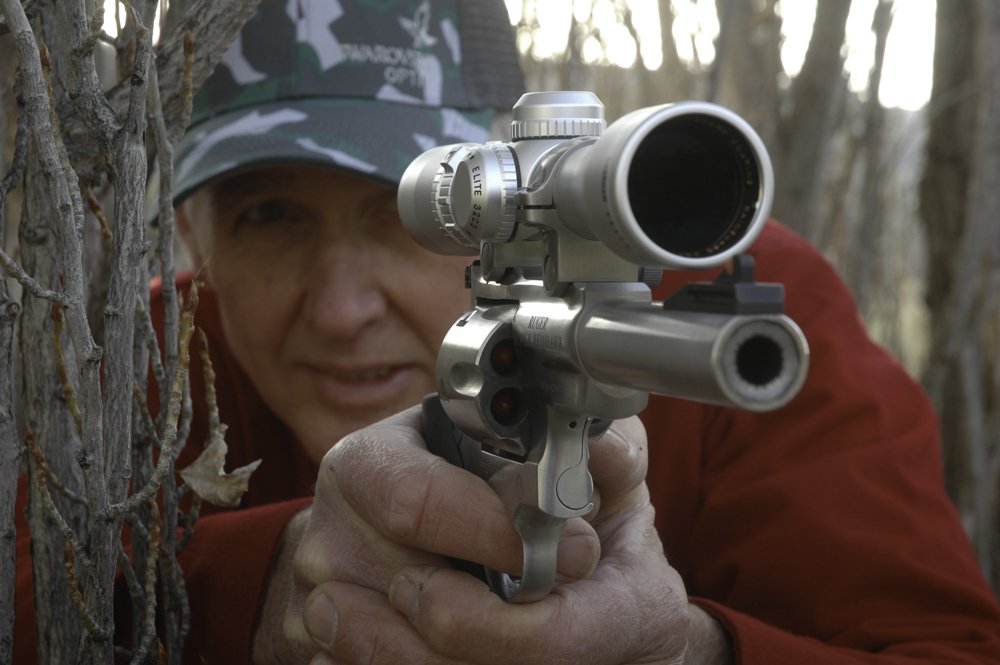
The Super Redhawk embodies features of the Redhawk — same triple-locking cylinder and offset cylinder notches that dodge the thinnest points in the cylinder. Same cylinder latch button and transfer bar ignition. The rear of the frame, the guard, trigger and hammer appear at a glance identical. Sights are the same too, albeit the SHR has an island ramp in the front, not a barrel-length rib. Both .44s have six-groove rifling with 1-in-20 right-hand twist.
Internally, however, the two revolvers are quite different. The Super Redhawk has the “peg” grip frame of Ruger’s GP-100 instead of the Redhawk’s traditional full-size grip frame. All three coil springs behind the standing breech of a Redhawk operate nearly parallel with the cylinder and barrel axes. The biggest spring in the Super Redhawk is pretty much centered in the grip and runs parallel to it.
The SRH has not been chambered in .357 Magnum or .45 Colt; but since its introduction, Ruger has added the .454 Casull, .480 Ruger, .41 Magnum and 10mm Auto to the original .44 Magnum chambering. Of course, you can fire .45 Colt ammo in revolvers bored for the Casull. While Super Redhawks in .44 Magnum, .41 Magnum and 10mm have the fluted cylinders of the original, .454s and .480s lack flutes. All SRHs now feature Hogue Tamer Monogrips, to help absorb recoil and ensure a secure hold with wet, cold or gloved hands.
Content with my 5 1/2-inch Redhawk, I had little need for its longer, heavier progeny. Then, short months ago as I write this, Ruger announced a “distributor exclusive” for AcuSport. This 52-ounce Super Redhawk, available through any dealer served by AcuSport, wore a 6 1/2-inch barrel. Long enough to tap the potential of the .44 Magnum, and wring hunting accuracy from iron sights or scope, it seemed to my eye a perfect match for the leggy SRH frame. You don’t have to need a revolver to buy one. Though the price of Super Redhawks had risen from $510 at its debut to a starting MSRP of $1,159, I bit.
Revolvers have brought to bag only a few animals on my big game hunts, so by any measure I’m a rookie in this arena. But scoping the Super Redhawk with a Bushnell LER 2-6x variable gave it a lethal look indeed. So equipped, it was clearly a use-two-hands, find-a-rest handgun. Still, it balanced well and, unlike longer revolvers, this .44 felt more like a pistol than a carbine.
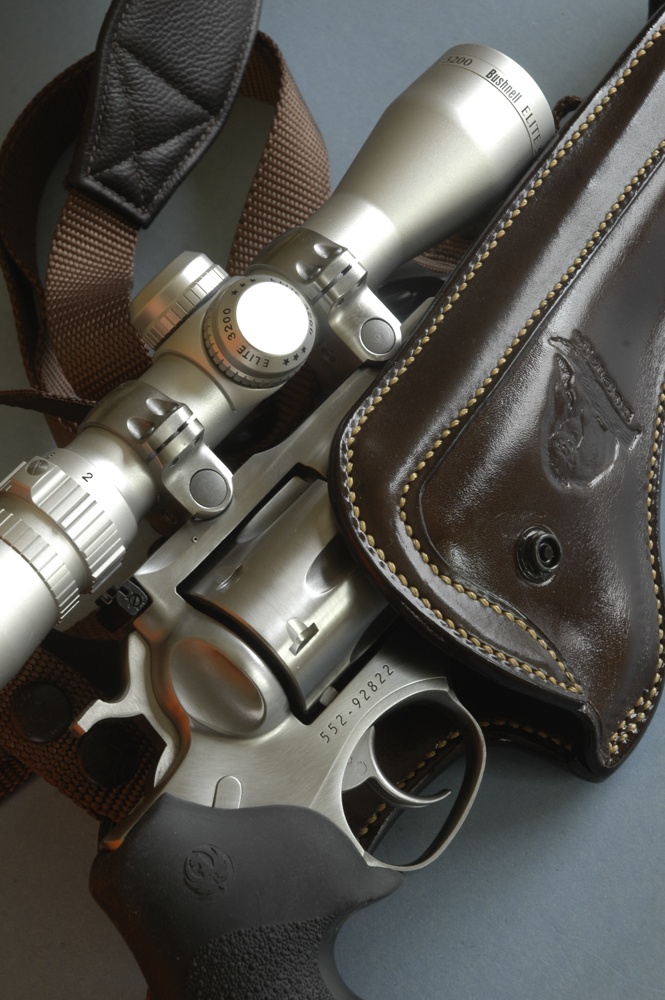
I usually zero big-bore handguns at 25 yards, for point-blank aim to 75. That’s near the effective reach of traditional bullets at 1,100 to 1,400 fps. Federal, for example, loads a 280-grain Swift A-Frame to 1,170 fps. Zeroed at 25, it hits an inch high at 50 yards, 3.7 inches low at 75. Federal’s 225-grain Barnes Expander at 1,280 fps reaches 50 yards just half an inch high and drops 2.8 inches at 75. These bullets fall 8.6 and 6.9 inches at 100.
After zeroing my Super Redhawk over a Caldwell bag, I tacked another target at a scope-friendly 50 yards and again took aim. Four bullets clustered inside 1.1 inches! Alas, fifth-shot gremlins would not be denied, and my final hollowpoint opened the group to 1.8. To my delight, a second series shot into 1.5 inches. I’m not skilled enough with a handgun to expect better. Nor is the SRH finicky. It herded all types and weights of bullets into snug knots. Black Hills 300-grain JHPs at 1,150 fps and 240-grain SIG JHPs at 1,300 delivered five-shot groups under 3 minutes of angle.
Now, 3-minute accuracy from a stock revolver with off-the-shelf ammunition would ordinarily put spring in my step. In this case, it posed a dilemma. I had just assured my editor at Gun Digest I could write compelling narrative about a revolver I prized above all others. One good gun. My Ruger Redhawk was now one of two good guns. Perhaps their common genesis, manufacture and features will ensure that both appear in the final copy. Both deserve the honor!
This article is an excerpt from Gun Digest 2019, 73rd Edition. Click here to learn more and get your copy of “The World’s Greatest Gun Book.”
Get More Ruger Info:
- Great Ruger Guns
- Ruger No. 1
- Ruger Precision Rifle
- Ruger Blackhawk
- Ruger Single Six
- Ruger 10/22
- Ruger LCR
- Ruger LCRx
- Ruger 77/22
- Ruger 77/44
- Ruger SR1911
- Ruger Hawkeye
- Ruger Mark IV
- Ruger SR-556
- Ruger LCP II
- Ruger American Magnum
- Ruger American Rifle
- Ruger Gunsite Scout Rifle
- Ruger SR-762
- Ruger Red Label
- Ruger SR40
- Ruger Single Nine
- Ruger P345

Next Step: Get your FREE Printable Target Pack
Enhance your shooting precision with our 62 MOA Targets, perfect for rifles and handguns. Crafted in collaboration with Storm Tactical for accuracy and versatility.
Subscribe to the Gun Digest email newsletter and get your downloadable target pack sent straight to your inbox. Stay updated with the latest firearms info in the industry.

![Best Concealed Carry Guns In 2025 [Field Tested] Wilson Combat EDC X9S 1](https://gundigest.com/wp-content/uploads/Wilson-Combat-EDC-X9S-1-324x160.jpg)


![Best 9mm Carbine: Affordable PCCs [Tested] Ruger Carbine Shooting](https://gundigest.com/wp-content/uploads/Ruger-Carbine-Shooting-100x70.jpg)
![Best AR-15: Top Options Available Today [Field Tested] Harrington and Richardson PSA XM177E2 feature](https://gundigest.com/wp-content/uploads/Harrington-and-Richardson-PSA-XM177E2-feature-100x70.jpg)
